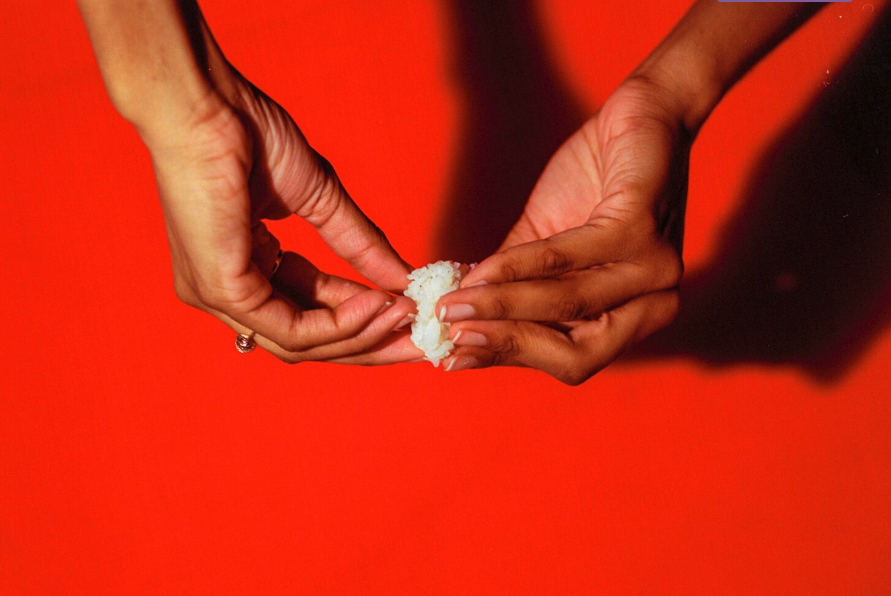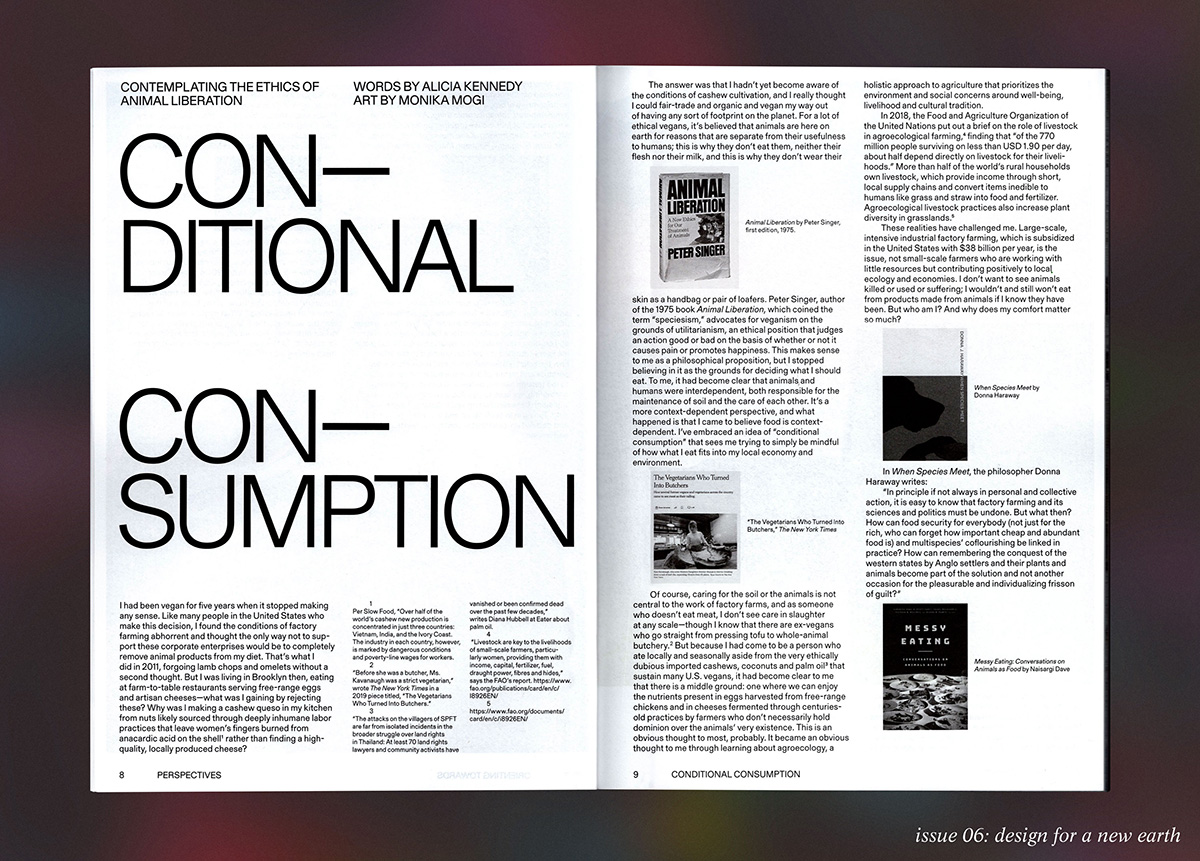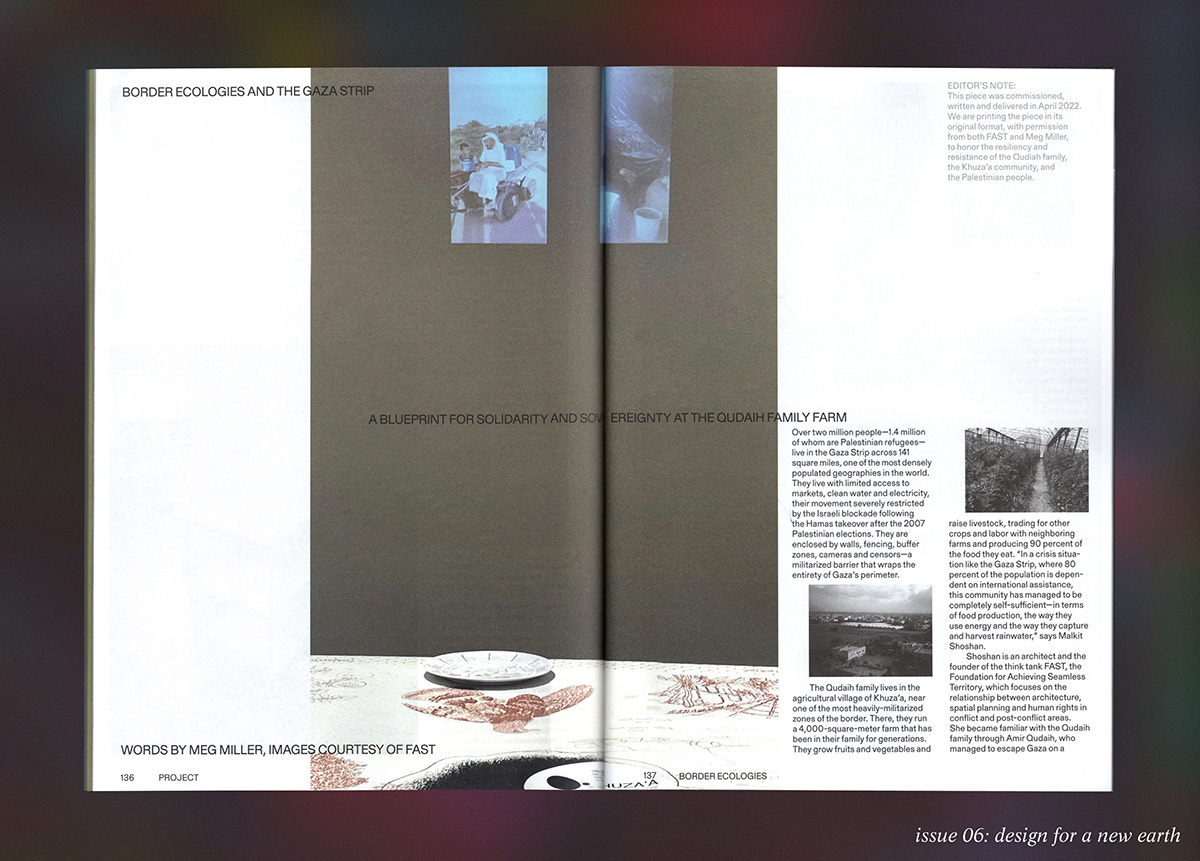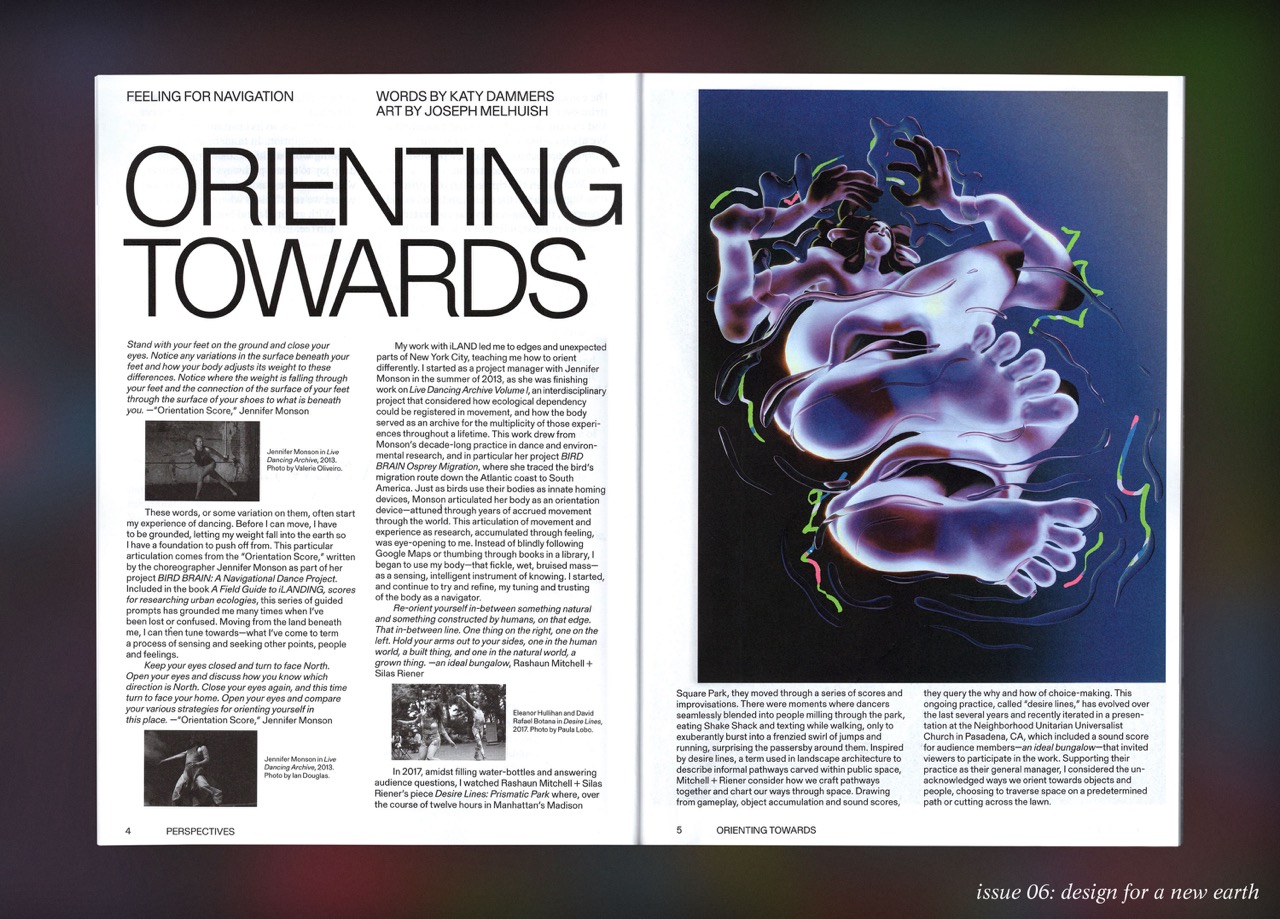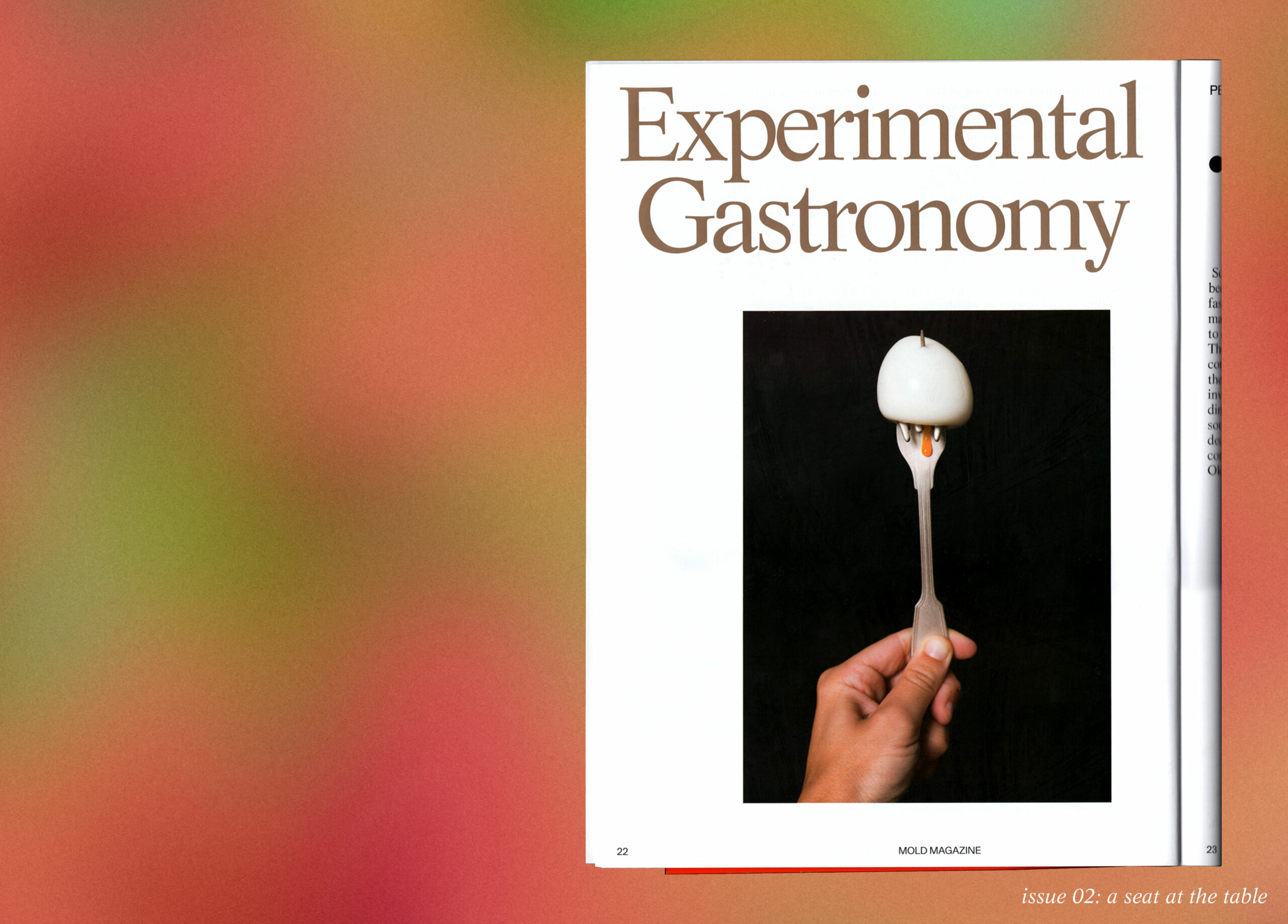This story is part of MOLD Magazine: Issue 04, Designing for the Senses. Order your copy of the full issue here.
Sitting at the table it’s the smell that arrives first. Steaming hot rice with a dollop of ghee, melting its way down to the core. The dal is a little over seasoned today, the extra jeera (cumin) tingles your nose. The plate is set down in front of you and you see the deliciousness—the bright yellow of the dal against the pillowy white rice, with pale ghee shimmering through in parts—looks exactly how you anticipated it from the smell. But before the taste—touch. You are much too eager and stick your fingers right in the center. HOT! Remembering your childhood, you say a prayer of thanks and start slowly mixing the rice from the outermost parts of the heap to avoid the heat of the center. The rice is as soft as your eyes said it would be and the dal is just right—not chalky or slimy. The temperature is perfect. Your fingers say you need a little more dal, and you listen to them, scooping some from the side and mixing the rice and lentils some more. Now, this feels right. You bring the morsel of rice and lentils up to your mouth and place it there for the tongue to receive. As you chew slowly, there is deep gratification—for the food tastes just as good as the fingers predicted. You have been transported back to that safe space where your mother fed you as a child.
Some months ago my friend Anusha and I got told off for eating dal-chawal (lentils and rice) with our hands at our Italian university by an elderly lady from the cleaning service. Anusha went on to tell her in broken Italian that our hands were probably cleaner than some of the utensils there. She laughed, in disbelief and shaking her head said, “Solo frutta e pane!” (Only fruit and bread!) Eating rice with our bare fingers was unacceptable!

Her disapproval didn’t deter us. Eating familiar food in a foreign land wasn’t enough. For us to be the most satisfied with our meal, even if Anusha burnt the sambhar or I over seasoned the poriyal, eating with our “bare” hands, wiping the last bit of yogurt from the plate, made every one of our meals complete.
Throughout history, people across the world have enjoyed food fed directly into their mouths with hands. In Rome 12 AD, people reclined on cushioned couches drinking plenty of wine (of course) while plucking at food with their fingers. Knives made of bronze or wood with iron blades were used to cut meat and spoons carved from bone, bronze or wood were used to drink soup. But there were no forks and the Romans ate with their hands.
We continue to have that tactile interaction with food in different degrees before it is presented to our mouths. The most minimal interaction is usually with food that’s not messy and easy to eat like the occasional pizza slice, fruit, sandwich or street snack. Here, the structure of the form of the food is the deciding factor in whether we use our hands or not.
Irrespective of ease of eating, culture plays the dominant role. In some cultures, we are taught not to eat with our hands at all. In others, food acts like an edible medium in the form of tortillas or mielie pap, and these traditions come with some interesting logic and long tales of folklore behind them.
Today, eating with the hand seems to be growing more uncommon. It took nearly a thousand years to find a non-reactive metal that didn’t make food taste bad, and then some colonization, or the fear of it, spread the culture of cutlery around the world.
In Thailand, the fork and spoon were introduced to priests and members of the royal court by King Rama V when he returned from Europe, and later on, a 1939 law prohibited people from eating rice with their hands, regulating the use of the spoon and fork as well as sitting at a table. Hand-eating traditions might resurface once a year with celebratory foods like mansaf, the national dish of Jordan made from rice and lamb, or on special occasions like the boodle fight. As our approach to food changes, how do our hands mold our eating experiences?
On creating a strategic sensory image
Chandragupta Maurya, the founder of the Mauryan Empire in ancient India, was said to have been returning home one evening, pondering over why it was still not possible to defeat the Nanda empire after multiple attempts. He chanced upon a mother handing her son a plate of hot rice and dal. With his hands, the child dives straight into the center of the plate and immediately pulls it away from the steaming pile. His mother scolds him, telling him to start from the sides and eat one bite at a time. Drawing inspiration from this strategy, Chandragupta attacked the Nanda empire from the outside in and finally conquered.
We eat with our eyes first. But for those of us who eat with our hands, we are conscious of mixing textures and temperatures. Tactile interaction with food gives a new dimension to the sensory input of smell, sight and taste. Touching food could be a fresh set of “eyes” before we taste and after we see and smell. Our fingers, like our lips, contain masses of nerve endings, and this would cumulatively contribute to the anticipation of food. The hands become the strategists that plan and execute the best temperature, texture and quantity that the mouth will receive.

Papa taught me to make tasty luqmas (a morsel). Take a bit of rice and then wet it with dal or the gravy of the meat, add a bit of vegetable and then mix it all well so each mouthful is artfully blended to produce a burst of flavour in the mouth. – Nandita Haskar, author.
Dr. Shikher Chaudhary, a cognitive neuroscientist and director of the applied neuroscience company Neurons Inc Asia, has conducted several studies on sensory experiences of certain food products: mainly packaging, olfactory and taste. He monitors the brain waves of people while they consume food.
“We find that a match between the expectation and reality shows increased activity in the left prefrontal cortex, indicative of positive emotional response, while a mismatch shows higher activity in the right prefrontal cortex, indicative of negative or avoidant emotional behavior,” he says. The high density of innervation in the fingertips creates pathways to discriminate between objects. Touching the food by mixing or adding ingredients, the fingers create pleasing and familiar textures. This manipulation of the food to our personal liking could create a match between expectations and reality. This positive match, influenced by our fingertips, strengthens the activity of the left prefrontal cortex, thus enhancing our eating experience.
Do you really like the feel of the cold spoon in the mouth? Furry cutlery and textured spoons are some of the innovations set to maximize positive tactile interactions similar to creating positive emotions. But here’s what’s more exciting about our hands. The nerve endings in the fingertips perform neural computations that were thought to occur in the brain. Neuroscientist Kruthika explains, “Watching a movie at home would be equivalent to eating with a spoon, and watching it in a theatre would be equivalent of eating with hands. A multi-sensory input, contributing to a single experience, would do a better job of engaging the brain.”
On body, mind, and gut: engaging the senses and the elements
I was observing my mother at dinner the other night. She detests using cutlery and only eats with her hands and, like every Indian mother, is a serial multitasker. Her phone pinged. WhatsApp probably. I was quite shocked when she ignored the notification. Coming from a woman who is constantly logged into some social media platform, this was unbelievable. She did hear it. But answering the phone and checking texts just wasn’t practical—her fingers were covered in food and she had no choice but to focus on the meal and talk to us.

When we sit down to eat a meal with our hands, it creates a situation (if we allow it) in which we are nudged to give full attention to the food we are eating, limiting mind-wandering activity and bringing awareness to the present moment, to the food and the people we are with.
As a cook, it is always stressed upon to touch, smell and engage with the ingredient. Touch is an important part of gauging if the fish is fresh or the fruits are ripe. This process creates a deeper connection with what we are about to cook. In many cultures, the hand is used as a tool of measure. The hand judges the exact amount of seasoning to make a dish perfect, not just for flavor but, as Ayurveda teaches, for subconsciously adding ingredients in the proportion that the body needs.
The body regenerates and replenishes itself based on what we eat and how we eat, not just connecting the senses but syncing the five elements in Ayurveda. In this form of traditional medicine, each of the fingers represents one element. Through the thumb, angushtha, comes space; through the forefinger, tarjani, air; through the mid-finger, madhyama, fire; through the ring finger, anamika, water, and through the little finger, kanishtha, earth.
The activity of eating with the hands activates the energies from these elements, creating a heightened consciousness in the body, preparing it for digestion. In this greater dimension eating becomes a mental, emotional and spiritual act of nourishment to the body.
On hand-flavor
My mom once explained to my teenage self that the secret was biochemical: the subtle oils of her fingers imparted some sort of alchemy to the little sphere—a pheromonal cocktail, I suppose—that would only fully blossom in the mouth of her offspring. Others would just call it maternal love. – Arun Venugopal, WNYC reporter.
The beauty of biodiversity is all the good bacteria and other microorganisms that can be of many services to us. They can keep pathogens in check, ferment bread and pickle vegetables all while helping our immune systems function properly.
In Korean culture, the concept of imparting flavor by the person who is making the food with their hands is known as ssom mhat (ssom meaning hand and mhat meaning taste). The person preparing the food is not just sharing the ingredients and their microbiome but also, in a sense, their personality. The same recipe prepared by different people is always different.
Studies have found that total diversity of bacteria on the hand surface exceeds the levels of bacterial diversity found in other human microbial habitats like the esophagus or the mouth. Interestingly, the palms of women harbor greater bacterial diversity than those of men. If you think handwashing might get rid of all those bacteria, no, it won’t. But don’t worry, that’s not a bad thing. Handwashing removes recently contracted microbes but not the ones that have established themselves on the hands.
Dr. Rob Dunn, biologist in the Department of Biological Sciences at North Carolina State University, conducted a global survey of nearly 568 sourdough starter samples through his eponymous lab and their Sourdough Project. The represented geographies were North America, Europe, Australia and one starter from Asia (Thailand).
This study identified that bread had its own “microbial” flavor influenced mostly by the mixing of the starter and the bakers’ hands. More interesting, the bakers’ hands had the same microbiome as that of the starter and the bread.
The microbes on our hands are not just interacting with the food we touch to cook or eat but they are also leaving their impression on us—a representation of our unique microbial flavor notebook of where we’ve travelled and touched.
Feeding children with the hand is common across hand-eating cultures. A mother is able to mash the food so it’s the right texture and not too hot for the child. Arun Venugopal’s mother was probably not wrong, she was feeding him her maternal love of experiences and moments curated in her own unique microbial hand flavor.
Sharing of microbes occurs not just in the hand but also through saliva when food is shared while eating together.
The first experience of solid food will differ according to the culture. If he is a Tikopian, he will get premasticated food, warmed with the mother’s body warmth, partly digested through her salivary juices; his mother will put it directly to his mouth with her lips. In our society, he will get food with a hard metal spoon, introduced into a mouth which has never experienced anything so solid or hard, into which not even teeth have yet erupted. – Dorothy Lee, Ph.D.
Dr. Cordelia Running, founder of the SPIT lab at Purdue University, is working on understanding saliva and how salivary proteins may influence food choice. “As we figure out how exactly these proteins in spit are related to the flavor, we might be able to figure out ways to change people’s spit to make healthy food taste better.”
Beyond flavor, could the saliva that is transferred onto the fingers while eating also help the hands with premastication, right there on the plate?

Finger-Lickin’—Good?
I have lived in Europe for 40 years. Every chance I have I use my fingers. I find incredible comfort eating with my fingers. It brings back memories. – Dr. Christiani Jeyakumar Henry, nutrition scientist.
Dr. Christiani Jeyakumar Henry, director of clinical nutrition sciences at the National University of Singapore, suggests that this unconscious finger licking creates a sense of satiety and represents completion and closure—the end to the act of eating. He continues:
Licking my fingers is incredibly exhilarating! The fingers in the mouth give me deep gratification.
One of the reasons children are said to suck their thumbs is to stimulate an emotionally safe space. The motion of the mouth on the thumb is said to make them feel they are in a comfortable environment. This might be relatable to licking fingers after a meal.
For the famed English naturalist Charles Darwin, the memories of hands and food, unfortunately, were not so comforting as he sat in a Yaghan camp at the southern tip of South America, opening a can of preserved beef. The year was 1834 and canning had just been invented some 20 years prior. “They liked our biscuit,” Darwin wrote, “but one of the savages touched with his fingers some of the meat preserved in tin cases which I was eating and feeling it was soft and cold showed as much disgust at it as I should have done at putrid blubber.”
It was not just disgust on the Yaghan man’s side: “I felt utter disgust at my food being touched by a naked savage, though his hand did not appear dirty,” analyzes Darwin.
As the brain assembles smell and taste into flavors and memories, it still remains an internal and personal experience. But when it comes to touch, the interaction of the hands sharing food becomes a form of communication. From an internal experience to a display of emotions and culture—satisfaction, disgust, comfort.
This victorious action of ending a meal by licking the fingers may not be comforting to other people who aren’t accustomed to the practice. KFC, the home of the “finger lickin’ good sauce,” introduced finger condoms in Japan so its customers could indulge in safe satiety—and be able to use their smartphones immediately after a meal. On the contrary, sushi etiquette is quite hands-on. In an interview with CNN, Michelin-starred chef Koji Sawada says he believes only the hands-on experience delivers the true sensuality of sushi.
So what could this mean? Is it right or wrong? Eating with hands moves beyond form or cultural context. It is heavily influenced by the situation and personal beliefs.
“Imagine you have never tasted a taco before, but you have seen many on social media, TV, movies, in books,” Oswaldo Oliva, chef-owner of Lorea and Aleli restaurants in Mexico City, posits. “You are presented one, but you are ashamed to use your hands in public. What causes more shame?” he asked us during an interview. “Using your hands [even though this makes you uncomfortable], or using fork and knife even though you know it’s completely absurd to do so?”
As a chef, Oswaldo believes that it is important to make proposals, as he calls the dishes he serves, that you truly believe in. Every culture, gastronomic reflection and insight goes through an individual’s particular filter. “I think it’s best to make an interesting proposal. I have found that people are more open to things when they are interesting and fun.” The menu at Lorea specifies to diners that the selection of appetizers is designed to be eaten with the hands.
The hands create our first physical connection to food. They are a tactile mediator that helps deliver taste expectations and a microbial descriptive journal of who we are as people. Eating, tasting, licking, teaching, digesting—the fingers work together in shaping a maximum experience, one that signifies intimacy with both food and family.
